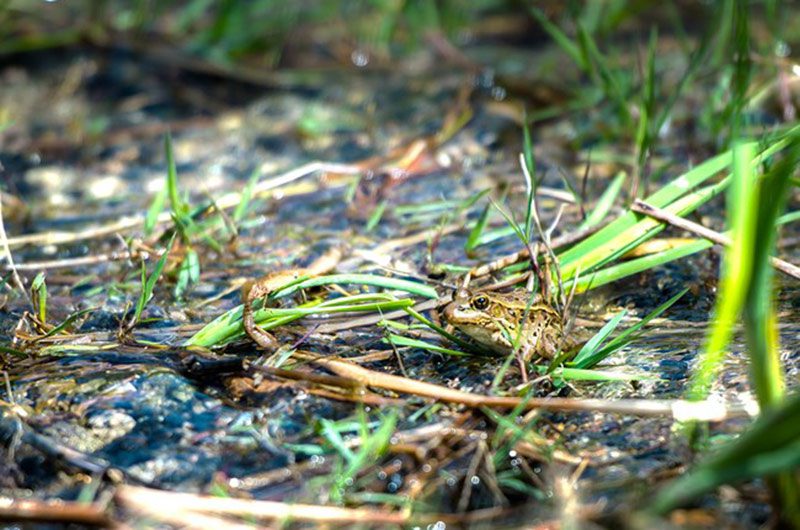LandPKS Learning
Habitat Hub

Relict Leopard Frog
The relict leopard frog was thought to be extinct in the 1950’s. It was rediscovered along the Virgin and Muddy Rivers in the 1990’s. This frog has not been seen in Utah along the Virgin River near St. George since 1950 and is thought to be extirpated from the state.
Lithobates onca
Identification
Relict leopard frog is small 1.75–3.5 in/4-9 cm. Like most leopard frogs, the relict leopard frog is a brown, grey, or green frog with greenish brown or brown spots. Relict leopard frogs often do not have spots above or between the eyes. International Union for the Conservation of Nature (IUCN) red list considers the relict leopard frog endangered. USFWS decided in 2002 that relict leopard frog listing under Endangered Species Act was warranted but other priorities were higher. Since that time, management has successfully expanded the number of sites occupied by relict leopard frog on federal lands.
Observation Tips
The relict leopard frog is found in Arizona and Nevada along the Virgin and Muddy Rivers as well as the springs in the Black Canyon below Lake Mead. They were also translocated into Tassi Spring within Parashant National Monument. They are also found in Lake Mead Recreation Area. The relict leopard frog is active at night.
Interesting Fact
The relict leopard frog was thought to be extinct in the 1950’s. It was rediscovered along the Virgin and Muddy Rivers in the 1990’s. This frog has not been seen in Utah along the Virgin River near St. George since 1950 and is thought to be extirpated from the state.
Ideal Habitat
Because so few frogs have been found, little is known about its ideal habitat, feeding and reproductive habits. Adults are thought to probably eat insects and tadpoles eat plants and algae. Adult frogs live in permanent streams, springs, and spring-fed wetlands with relatively clear shallow water. Adults prefer relatively open shorelines without dense vegetation (<40% herbaceous cover). At night they tend to select relatively open areas with minimal tall vegetation and during the day they spend more time in and near denser vegetation. Therefore, relict leopard frogs seem to prefer aquatic habitat heterogeneity.

Range map provided by International Union for Conservation of Nature
Management Activities that Benefit Species – Best Management Practices (BMPs)
Protect and maintain natural springs, seeps and streams that were historically or are currently occupied relict leopard frog habitat. The relict leopard frog is only currently known from a few isolated areas so many things can threaten its continued existence. Nonnative fish, bullfrogs and crayfish should be controlled when possible in and near occupied habitat. Captive breeding and reintroduction into appropriate habitat is one strategy to conserve the relict leopard frog.
Allow reintroductions and translocations if you have historic habitat on your lands. Invasive emergent plant species and dense vegetation along spring and stream shorelines should be managed to provide some open conditions that relict leopard frogs want. Well-managed livestock grazing using rotational grazing systems should provide heterogenous vegetation conditions while maintaining relatively clear water.
Management Activities to Avoid
Avoid habitat conversion to urban or residential development as well as cropland. Avoid introduction of bullfrogs, crayfish, and nonnative fish into occupied habitat. Avoid significant water withdrawal and hydrological alteration of relict leopard frog occupied habitat.
Other Species that Benefit from Similar Habitat Management
Management for relict leopard frog will benefit other spring-dependent species.
Download
Download the Relict Leopard Frog factsheet
Descarga la ficha de rana leopardo
Other Resources
International Union for Conservation of Nature (IUCN). 2014. The IUCN Red List of Threatened Species. Version 2021-1 Relict leopard frog
National Park Service. Grand Canyon-Parashant Relict leopard frog and Lake Mead. Relict leopard frog
NatureServe. 2021. NatureServe Explorer: An online encyclopedia of life [web application]. Version 7.1. NatureServe, Arlington, Virginia Relict leopard frog
Relict Leopard Frog Conservation Team. 2016. Conservation Agreement and Conservation Assessment and Strategy for the Relict Leopard Frog Report
Utah Wildlife Sensitive Species Relict leopard frog
USFWS. Relict leopard frog
Mobile App | Data Portal | Knowledge Hub | Habitat Hub | Learning Collections | Blog | About | Contact | Support



